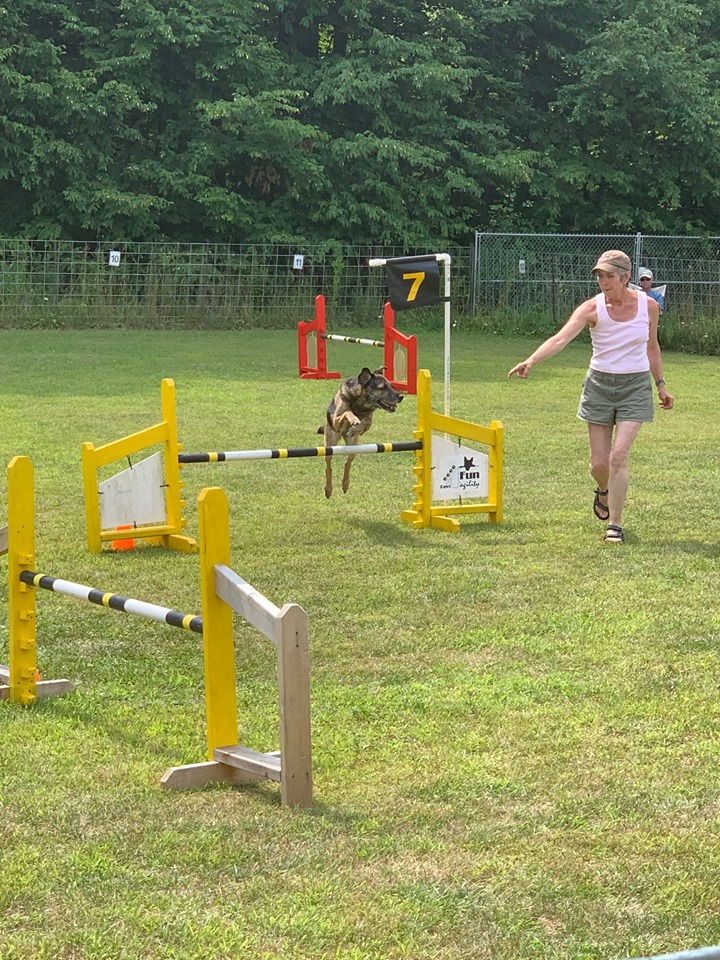For my agility students...
- Hotdiggity Dog Training
- Aug 3
- 3 min read

I started in agility in 2000 with my dog, Shiloh. He was a yellow Lab that I adopted when he was 14 months old, completely untrained. I took him to obedience classes and although he eventually agreed to do some of the things I was trying to teach him, I recognized that what I was missing was a connection to this headstrong dog.
So when I read about a new agility group starting up in Dunrobin, I thought that might be a way to bond with him, so I contacted them, and … well you know the rest. Shiloh, my Beautiful Boy, is no longer here, but I am. Still running dogs in agility, still teaching, still loving it.
From the very beginning of my involvement with agility, I have believed that it’s all about the bond we have with our dogs, not about the ribbons. I don’t care what my dogs do on the agility field, as long as we are connected, as long as we are working as a team. A happy team. And that’s how I teach classes.
Anyone who has been in my classes knows I am very picky about handling. I want the shoulders, hands, and feet providing information to the dog that is timely, clear, and consistent. I want front crosses and rear crosses placed on the diagonal. I want students to understand the difference between a threadle and a serpentine, and to indicate clearly to their dogs which one they’re using. I want high arms on the contact equipment, and low arms on the tunnels. I want timely decelerations for tight turns, and arm pumping intent for acceleration. I want it all.
No, I’m not asking for perfection. What I’m asking for is an awareness that clear communication is important. When you are consistent in your body language – the language dogs most easily understand -- your dog learns to trust that you know what you’re doing. When you accelerate down a line of jumps, your dog trusts that you won’t suddenly change direction and that she can fly fast over them. When you correctly threadle your dog in between two jumps, your dog learns to trust that you will provide sufficient warning for her to land on the correct leg so that she can change direction quickly and safely. When you use a high arm on the dog walk to differentiate between it and a tunnel, your dog learns to trust your choice.
Because at its core, agility is all about trust. You and your dog have to trust each other to complete the exercise or course smoothly and correctly. Without that trust, your dog will be unwilling to move ahead of you, and will move slowly and hesitantly. She will constantly watch you in case you suddenly stop or change direction.
Similarly, you have to trust your dog to make the right choices. When people don’t trust their dogs, they micromanage them, carefully escorting them around corners, or waiting to make sure they walk up the contact obstacle or enter the tunnel.
Often, when I’m providing feedback to a student about their handling, they will respond with “well, my dog did it anyway”, and the underlying message is “so it doesn’t matter that I didn’t get my front cross in the correct spot”. Sure, that’s true. THAT time. But their dog is not learning to trust them. And as the courses get more sophisticated as students move up the levels from Novice to Intermediate to Advanced, that “end-justifies-the-means” attitude will come back to bite them in the butt. If their dog doesn’t trust them, they will never get the distance or the speed or the finesse they need for the more advanced courses.
Nothing is more thrilling in agility than watching a handler and dog perform together, to trust each other. I’m always overjoyed to see that connection between handler and dog, and I recognize that it took a lot of time and patience to get there. Because trust doesn’t just happen, it has to be earned, one small move at a time.
.png)



Comments